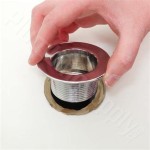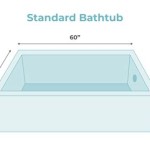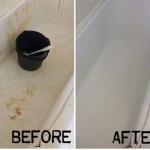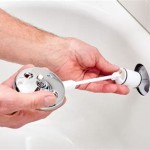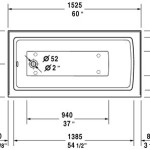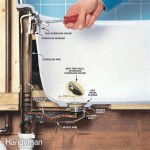Bathtub Resurfacing Cost Sydney: A Comprehensive Guide
Bathtub resurfacing, also known as reglazing or refinishing, is a cost-effective alternative to bathtub replacement in Sydney. It involves restoring the surface of an old, damaged, or outdated bathtub to its original condition or giving it a completely new look. This process can significantly extend the lifespan of a bathtub while avoiding the disruptive and expensive undertaking of a full replacement. Understanding the factors influencing bathtub resurfacing cost in Sydney is crucial for homeowners looking to revitalise their bathrooms without breaking the bank.
Several elements contribute to the overall cost of bathtub resurfacing in Sydney. These include the size and type of the bathtub, the extent of the damage, the chosen resurfacing method and materials, and the labor costs involved. It's essential to obtain detailed quotes from reputable service providers to accurately assess the potential investment. This article provides a comprehensive overview of the factors that influence bathtub resurfacing costs in Sydney, helping homeowners make informed decisions and achieve the desired results within their budget.
Factors Influencing Bathtub Resurfacing Costs
Several key factors determine the final cost of resurfacing a bathtub in Sydney. Understanding these factors will allow homeowners to better estimate the overall expense and choose the most suitable option for their specific needs and budget.
Bathtub Size and Type: The size and type of bathtub significantly impact the resurfacing cost. Larger bathtubs require more materials and labor, consequently increasing the price. Similarly, different bathtub materials, such as cast iron, steel, or acrylic, may require specific resurfacing techniques and products, further influencing the overall cost. For instance, cast iron bathtubs, known for their durability, often require more extensive preparation due to potential rust and corrosion, leading to higher labor costs. Acrylic bathtubs, on the other hand, may be more susceptible to scratches and require specialized coating materials to ensure long-lasting results.
Extent of Damage: The condition of the existing bathtub plays a crucial role in determining the resurfacing cost. Minor scratches, chips, or stains can be addressed with relatively simple and cost-effective resurfacing techniques. However, if the bathtub has significant damage, such as deep cracks, rust, or water damage, the resurfacing process will require more extensive repairs, increasing the overall cost. In some cases, extensive damage may make resurfacing impractical, and a full replacement might be a more viable option. A thorough assessment of the damage is essential to determine the appropriate resurfacing approach and estimate the associated costs accurately. It is important to note that addressing underlying structural issues could incur further expense.
Resurfacing Method and Materials: The chosen resurfacing method and the quality of the materials used significantly impact the final cost. Various resurfacing techniques exist, including spraying, rolling, and brushing. Each method has its own advantages and disadvantages in terms of cost, durability, and finish quality. Spraying typically delivers a smoother, more even finish but requires specialized equipment and skilled technicians, making it a more expensive option. Rolling and brushing are more cost-effective but may not achieve the same level of surface quality. The type and quality of the coating materials also influence the cost. High-quality epoxy or acrylic urethane coatings offer superior durability, stain resistance, and gloss retention but come at a higher price than cheaper alternatives. Selecting the appropriate resurfacing method and materials is crucial for achieving the desired aesthetic and performance while staying within budget.
Labor Costs: Labor costs constitute a significant portion of the total bathtub resurfacing cost in Sydney. The skills and experience of the resurfacing technician directly influence the quality of the work and the overall cost. Hiring a qualified and experienced professional ensures proper surface preparation, application of the coating materials, and adherence to safety standards. Experienced technicians can also identify and address potential problems, such as hidden leaks or structural issues, preventing future damage and cost escalation. Labor costs can vary depending on the complexity of the job, the time required to complete the project, and the location within Sydney. It is advisable to obtain multiple quotes from reputable resurfacing companies to compare labor costs and ensure a fair price.
Additional Costs: Beyond the core resurfacing process, several additional costs may arise. These include the cost of removing and disposing of old fixtures, such as faucets and drain covers. If the surrounding tiles or grout are damaged, repairing or replacing them will add to the overall cost. Furthermore, some homeowners may opt for additional services, such as slip-resistant coatings or custom color matching, which will incur additional fees. It is essential to discuss these potential additional costs with the resurfacing contractor upfront to avoid unexpected expenses. Proper ventilation is also a must during the resurfacing process; if the bathroom's ventilation system is inadequate, the cost of temporary ventilation might need to be factored in.
Average Bathtub Resurfacing Costs in Sydney
While the specific cost of bathtub resurfacing in Sydney can vary depending on the factors outlined above, it is possible to provide a general range to give homeowners a preliminary understanding of the potential investment. The average cost of bathtub resurfacing in Sydney typically falls between $400 and $1200. This range reflects the variations in bathtub size, damage extent, resurfacing method, and labor costs. Simple resurfacing jobs involving minor repairs and a basic coating application may cost closer to the lower end of the range, while more complex projects with significant damage, specialized coatings, and custom finishes can reach the higher end. It is crucial to obtain multiple quotes from reputable resurfacing companies to compare prices and assess the value offered. These quotes should include a detailed breakdown of the materials, labor, and any additional costs to ensure transparency and avoid hidden fees.
Factors that can push the price towards the higher end of the range includes working on antique or clawfoot bathtubs, which often require specialized techniques and materials. Working on these types of bathtubs may increase labor costs due to the increased complexity and time involved.
When considering resurfacing costs, it is important to compare them to the cost of bathtub replacement. Replacing a bathtub can be significantly more expensive, involving demolition, plumbing work, tiling, and disposal fees. The cost of a new bathtub itself can range from a few hundred dollars to several thousand dollars, depending on the material, size, and features. Adding to this the labor costs for installation which can easily double the price, or more. Therefore, bathtub resurfacing can offer substantial savings while still achieving a revitalized and aesthetically pleasing bathroom.
Benefits of Bathtub Resurfacing
Beyond the cost savings, bathtub resurfacing offers several other benefits that make it an attractive option for homeowners in Sydney. These benefits include convenience, minimal disruption, and environmental friendliness.
Cost Savings: As previously mentioned, bathtub resurfacing is a significantly more cost-effective alternative to bathtub replacement. This is especially true for homeowners on a tight budget or those looking to renovate their bathroom without incurring significant expenses. The savings can be substantial, particularly when considering the additional costs associated with replacement, such as demolition, plumbing, and tiling.
Convenience and Minimal Disruption: Bathtub resurfacing is a much less disruptive process than bathtub replacement. It typically takes only a few hours to complete, minimizing the inconvenience to homeowners. In contrast, bathtub replacement can take several days or even weeks, requiring extensive plumbing, demolition, and construction work. Resurfacing also avoids the mess and noise associated with these activities, allowing homeowners to continue using their bathroom with minimal interruption.
Environmental Friendliness: Bathtub resurfacing is an environmentally friendly option compared to bathtub replacement. By resurfacing an existing bathtub, homeowners avoid the landfill disposal of the old bathtub, reducing waste and conserving resources. The resurfacing process also uses fewer materials and energy than manufacturing a new bathtub. Choosing bathtub resurfacing reflects a commitment to sustainability and responsible environmental practices.
Extended Bathtub Lifespan: Bathtub resurfacing can significantly extend the lifespan of an existing bathtub. The new coating protects the underlying surface from further damage, such as rust, corrosion, and staining. With proper care and maintenance, a resurfaced bathtub can last for many years, providing a durable and aesthetically pleasing bathing experience. This prolongs the time before a replacement is needed, further saving costs and reducing environmental impact.
Improved Aesthetics: Bathtub resurfacing can dramatically improve the aesthetics of a bathroom. A resurfaced bathtub looks brand new, free from scratches, stains, and other imperfections. Homeowners can choose from a variety of colors and finishes to match their existing bathroom décor or create a completely new look. This can enhance the overall appeal and value of the home.
In conclusion, understanding the factors influencing bathtub resurfacing cost in Sydney is crucial for homeowners seeking a cost-effective and convenient way to revitalize their bathrooms. By considering the size and type of bathtub, the extent of the damage, the resurfacing method and materials, and the labor costs, homeowners can make informed decisions and achieve the desired results within their budget. Bathtub resurfacing offers numerous benefits, including cost savings, minimal disruption, environmental friendliness, and improved aesthetics, making it a smart choice for homeowners looking to enhance their bathrooms without the expense and hassle of a full replacement.

The Cost Of Resurfacing A Bathroom Shower Bathtub Tiles

Bathroom Bathtub Resurfacing Cost 2024 Oneflare

Bath Resurfacing Sydney Ab

Bathroom Resurfacing Renovation Sydney Wide Reglazing

Bathroom Renovations Bath Restoration Resurfacing

Bathroom Resurfacing Sydney Thermoglaze

Budget Bath Resurfacing Sydney

Bathroom Resurfacing Sydney All Class

Bath Resurfacing Sydney Ab

Bathtub Refinishing Todds Porcelain Fiberglass Repair

